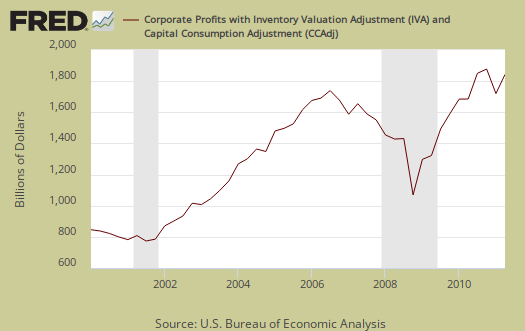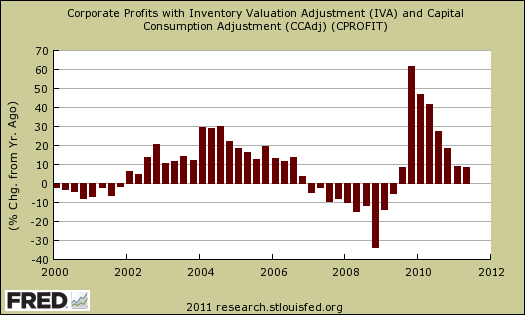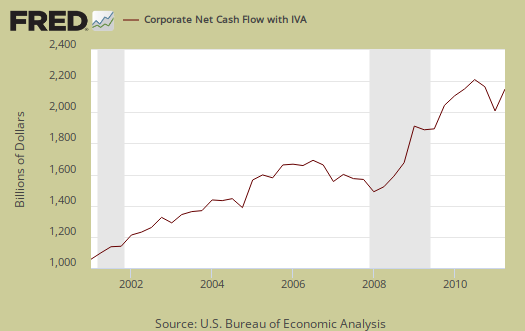The BEA released corporate profits for Q2 2011 along with the Q2 2011 2nd revision. While the United States continues to experience economic malaise, corporate profits are alive and well.

Pre-tax Corporate profits increased 3.0% from Q1 and 8.3% from one year ago.

What is astounding is the massive amount of cash corporations have for investment. Net cash flow increased $83.8 billion from Q1 and corporations now have over $1.8 trillion dollars available for domestic investments and hiring people, which everyone in America is aware they are not doing, astounding.

This quarter the financial sector didn't do so well, their profits declined.
Domestic profits of financial corporations decreased $54.2 billion in the second quarter, compared with a decrease of $38.7 billion in the first.
Quarterly tax receipts also declined for Q2, -$3 billion in comparison to $17 billion in the first. That said, to truly get a feel for how much corporations are really paying, or not, one needs to look at annual returns.
Profits after tax with inventory valuation and capital consumption adjustments, increased 4.1% for Q2 2011 and are up 9.2% from last year. The BEA reports corporate profits in a variety of ways and it seems whatever one's focus and political predilections are implies which number they use.
From the BEA's magic secret decoder ring guide to National Income and Product Accounts (large pdf), national income also uses inventory valuation and capital consumption adjustments. Their reasoning for inventory valuation is this:
Inventory valuation adjustment (IVA) is the difference between the cost of inventory withdrawals valued at acquisition cost and the cost of inventory withdrawals valued at replacement cost. The IVA is needed because inventories as reported by business are often charged to cost of sales (that is, withdrawn) at their acquisition (historical) cost rather than at their replacement cost (the concept underlying the NIPAs). As prices change, businesses that value inventory withdrawals at acquisition cost may realize profits or losses. Inventory profits, a capital-gains-like element in business income (corporate profits and nonfarm proprietors’ income), result from an increase in inventory prices, and inventory losses, a capital-loss-like element, result from a decrease in inventory prices.
The mysterious capital consumption adjustment, along with inventory valuations, derives current production income.
The private capital consumption adjustment (CCAdj) converts depreciation that is on a historical-cost (book value) basis—the capital consumption allowance (CCA)—to depreciation that is on a current-cost basis—consumption of fixed capital (CFC)—and is derived as the difference between private CCA and private CFC.
Since this is what the BEA uses for national accounts and makes much more sense from a business accounting perspective generally, seems the above before and after tax numbers are the right metrics to use when thinking about corporate profits from a national and macro-economic perspective.
If the above magic secret BEA decoder ring didn't make much sense, try this one:
Corporate profits with inventory valuation and capital consumption adjustmentsis the net current-production income of organizations treated as corporations in the NIPA's. These organizations consist of all entities required to file Federal corporate tax returns, including mutual financial institutions and cooperatives subject to Federal income tax; private noninsured pension funds; nonprofit institutions that primarily serve business; Federal Reserve banks; and federally sponsored credit agencies. With several differences, this income is measured as receipts less expenses as defined in Federal tax law. Among these differences: Receipts exclude capital gains and dividends received, expenses exclude depletion and capital losses and losses resulting from bad debts, inventory withdrawals are valued at replacement cost, and depreciation is on a consistent accounting basis and is valued at replacement cost using depreciation profiles based on empirical evidence on used-asset prices that generally suggest a geometric pattern of price declines. Because national income is defined as the income of U.S. residents, its profits component includes income earned abroad by U.S. corporations and excludes income earned in the United States by the rest of the world.
Bottom line Q2 shows the same thing we've seen for some time, corporations are slashing their workforce and sitting on cash instead of using it to hire and expand (uh, domestically).

Recent comments